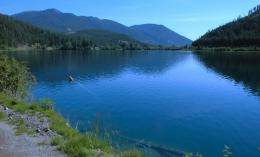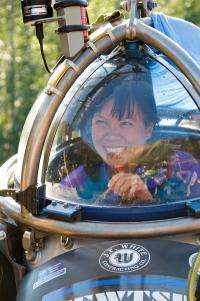Scheduling the unknown

How can the exploration of a Canadian lake, using deep-water submersibles, help NASA plan for the human exploration of Mars?
What’s the most effective way to explore an unknown world? That’s one question that members of the Pavilion Lake Research Project (PLRP), with a bit of help from NASA mission planners, hope to address this summer when they conduct their first comprehensive underwater study of Kelly Lake in British Columbia, Canada.
Each summer for the past several years, PLRP scientists and astronauts have joined forces to explore another British Columbian lake, Pavilion Lake. On its surface, Pavilion Lake is a typical freshwater mountain lake. Underwater, however, it is home to a very unusual phenomenon: its lakebed is covered with a virtual forest of microbialites, formations believed to have been built by microscopic organisms, and widespread on early Earth but rare in modern times.
This year, instead of continuing their work at Pavilion Lake, PLRP scientists will be exploring nearby Kelly Lake, which contains a less-extensive population of microbialites.
At the heart of the work at Kelly Lake will be the underwater exploration of the lake in a pair of DeepWorker mini-submersibles, built and managed by Vancouver, British Columbia-based Nuytco Research. But submersible “flight” time – PLRP refers to DeepWorker sojourns as flights – will be limited. The subs will be available for only a week, and each flight is a taxing journey in a pressurized vehicle into a dangerous and alien environment, where life-support factors such as battery power, oxygen supply and pilot fatigue must be given priority consideration.

In an effort to maximize their scientific return, PLRP will be using planning software developed by the Human-Computer Interaction Group at NASA Ames Research Center initially as a task-planning tool for NASA’s Mars Exploration Rovers.
“As a group,” says Mike McCurdy, who leads that software-development group, “we’ve been interested in the analogs for a while, essentially as test beds for future tool development.” Analogs are scientific research sites on Earth where some aspect of the environment or the research process is similar to what future explorers on other worlds, particularly Mars, may face.
Score, a version of the software built by McCurdy’s group, is currently being modified, in partnership with mission planners at NASA’s Johnson Space Center (JSC), for deployment on the International Space Station (ISS). Both members of McCurdy’s team and a group of JSC mission planners familiar with ISS procedures will participate in this year’s PLRP activities, using Score to detail the timeline for sub flights and any critically related pre-and post-flight activities.
“The project has reached a critical mass and I cannot manage it as I did when it was smaller” any more, says Darlene Lim, PLRP’s principal investigator. “That worked when we were 20, maybe 50 people. But we’ve gone beyond that.” As many as 80 researchers and support personnel are expected to take part this year’s fieldwork.
A timing glitch anywhere in the process can cause setbacks that ripple throughout the project and compromise its scientific goals. If pilots or support personnel are not where they need to be, sub flights will be delayed. If sub flights are delayed, researchers may not get the data or samples they need.
That’s where the expertise of the mission-planning team from JSC will come into play. “We’re hoping,” says Lim, that they “can automate that process for us, bring their experience to the program, help us to streamline our movements and just make us much more efficient.”
Like McCurdy, JSC’s Lauren Rush, who led the planning of a recent Space Shuttle mission and will be the lead planner at Kelly Lake, sees the collaboration between her group and PLRP not only as benefitting PLRP, but also as helping mission planners think about the future of human spaceflight.
“I think that [PLRP] is very applicable to future missions, because it’s the same idea. It’s putting a crew in a rover, equipping them with what they need to go and do,” she says.
One important difference between Space Shuttle planning and planning for PLRP, though, is that with the Shuttle crew, “We know where they’re going to be.” But at Kelly Lake, she points out, people will be “spread out from the mission-control-center trailer, to the barge [the floating platform from which the subs are launched], to a submarine, to somewhere on the side of the lake.” Or in the worst case, in a hotel room, 20 minutes’ drive away. “Looping them together I think is going to be a challenge.”
Another difference between a scientific expedition like PLRP and a Space Shuttle or ISS mission is the level of autonomy given to the participants. On Shuttle and ISS missions, Rush says, “We tell the crew exactly what they’re going to do, broken down into five-minute increments of every day that they are in space, from launch until landing…. From the time they wake up until the time they go to bed, every single thing that they do throughout the day.” Including bathroom breaks.
But Kelly Lake will be a mission of exploration. Once they descend below the lake’s surface, a sub pilot may make an unexpected discovery that he or she wants to take unscheduled time to pursue. Learning how to accommodate the give and take of the exploration process is one of main ways McCurdy and Rush believe their groups will benefit from working with PLRP.
“Pavilion is particularly interesting because it is a real science mission,” says McCurdy. “I see a lot of similarity between the priorities of the Pavilion team and the priorities of the Mars folks that we worked with in the past, in terms of really wanting to maximize the science output of the mission…. In some ways, that’s our bread and butter. That’s where our tools got their start.”
Although Lim has high hopes for this three-way collaboration, she knows there could “be problems around the edges. I’m expecting that,” she says. “We don’t know exactly how we’re all going to work together yet.”
She is “at once completely frightened and completely excited” by the prospect of delegating responsibility for a critical aspect of her project to an outside group. “I feel like they’re there to keep us in line with what we intended to do … but also respond to the fact that we are a bunch of field scientists interested in doing science, not interested in being scripted to the second.”
Source: Astrobio.net


















